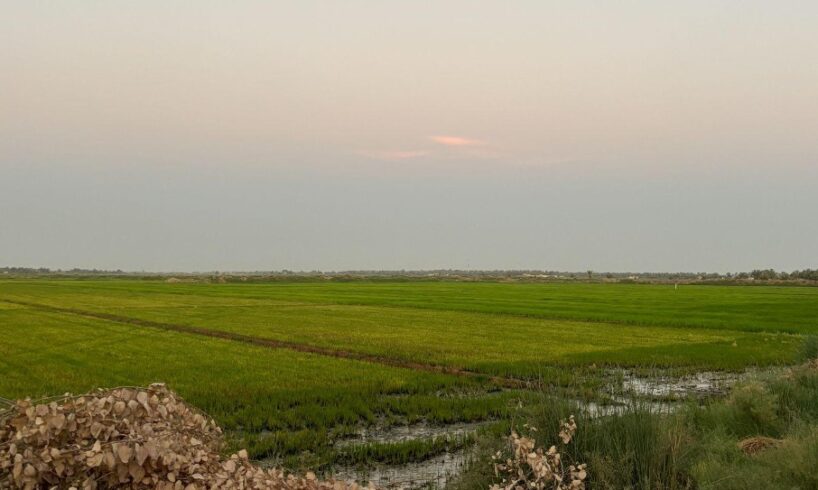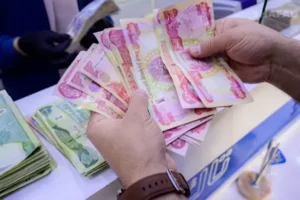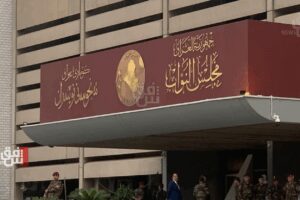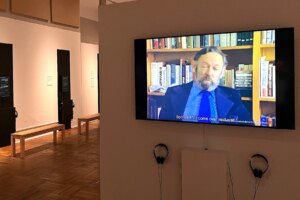
(Photo: Noor Kareem)
Amber rice, known for its strong sweet aroma, is deeply embedded in Iraq’s identity. For the crop to flourish, rice fields must be submerged in water for months. However, years of drought have transformed the rice fields and the landscape of Qadisiyah province. When I returned to Iraq in the summer of 2022, I was struck by how much had changed over the last ten years. The rivers were noticeably lower, and the bright green crops that bordered the Euphrates were replaced with yellowed barren soil. Beyond the visual transformation, the smell of the rice had waned and the taste of the staple food that had once accompanied meals vanished from daily life. That year marked a severe decline in Iraq’s agricultural productivity, with output falling by nearly 50 percent. However, in 2024, there was an increase of water that made it possible for large landowners to plant rice in Shamiyah, a city in Qadisiyah. I initially sought to understand whether the return of water was the result of improved policy or simply increased seasonal rainfall. While it turned out to be largely the latter, the way locals discussed the change revealed deeper insights.
While international organizations and foreign researchers framed the water shortage as a matter of climate change, embodied by the unreliable but oft-cited figure that “Iraq is the fifth most vulnerable country to climate change,” Iraqi landowners and farmers questioned this discourse. When speaking to local landowners, most were well aware of upstream water politics, particularly Turkey’s role in restricting water flow, and were in tune with local and national water management conversations to combat the water shortage.
One landowner by the name of Abu Hassan elaborated on the interconnectedness of Iraq’s water shortage, “Turkey keeps shutting down the water on us. Everything is connected. The Tigris and Euphrates are linked. When Turkey finished [building and filling the Ilisu dam] on the Tigris in 2018, the drought suffocated us here.” Though the Tigris and Euphrates do not converge until they reach the Shatt Al-Arab basin, the disruption of one river’s flow inevitably impacts the other. Some statistics indicate that the Ilisu dam reduced the water flow into Iraqi river basins by 34 percent from the previous year. When asked about climate change, Abu Hassan explained that Turkey controls the water, and when the dams were completed in the late 2010s, crops died, heat became unbearable, and animal populations declined. At the same time, the government is unable to relieve the water shortage and alleviate the pressure on rice farmers.
Last summer, the government responded to protests by allocating one third of pre-2018 water level to all landowners. For large landowners like Abu Hassan, the one third allocation of pre-2018 water levels rule was disappointing but manageable, “We get 30 percent of the water we used to get. We still grow, but not enough. It’s not conducive to farming.” For small landowners, this law did not accomplish much. “Farmers who aren’t near the river barely get any water at all. People keep moving to the city, turning to the public sector, working in small stores, if they can join the army, they will. Few farmers remain, many use this land just for housing.”
Abu Hassan, an older man, recalls his father’s way of life, “Before, the earth was truly fertile, we had ‘ghirian’ (pure) water, compatible with growing rice without fertilizers. You put a seed in the ground, and it will grow without fertilizers or advanced technology,” he explained, painting a nostalgic picture of a self-sustaining agricultural tradition tied closely to the natural rhythm of the land and rivers. This heightened memory of agricultural abundance contrasts starkly with the challenges he faces today. For farmers, the knowledge, tools and techniques passed down through generations are vital to resisting the erosion of their identity and way of life, even as their agricultural practices face mounting challenges. Abu Hassan shared, “Since our grandfathers, definitely since the 1800s, we have lived in Shamiyah. Before, we had old types of rice like al-Naiaima and al-Hawazawi, then we got newer types of rice like Jasmine which doesn’t require much water.”
When I explicitly asked about climate change in the area, the landowners I spoke to expressed skepticism or disinterest, prioritizing the conversation about corruption and the relationship between the local officials and the Ministry of Water Resources in Baghdad. Climate change was seen as an abstract and foreign representation disconnected from their lived experiences. This aversion is found across the board in Iraqi society and is not rooted in a lack of awareness. This parallels a conversation I had with an Iraqi water expert who acknowledged that international entities like the United Nations, the European Union, and USAID have made attempts to support Iraq through initiatives focused on water conservation. However, at the same time, he stated “nowadays climate change is more or less like a trend everywhere. Each player works on a short-term initiative and then disappears.” This skepticism of climate discourse reflects a deeper mismatch: international climate narratives often reduce Iraq’s complex environmental challenges to technical metrics and crisis language, overlooking the entanglements of corruption, mismanagement, and infrastructural decay that shape how Iraqis understand water scarcity.
The disconnect between lived realities and global narratives is reflected in how international organizations frame climate change in Iraq. Dominant narratives from academic studies to international climate reports often frame changes in water access in places like Shamiyah through the prism of water scarcity primarily attributed to climate change and exacerbated by other factors. Moreover, the water crisis is taken as a starting point, with scholarship often centering the phrase “Iraq is the fifth most vulnerable country to climate change,” and proceeding to provide statistics on dwindling water levels, rising temperatures, and desertification among other factors. Media outlets like The New York Times are not exempt from using this figure.
Iraqi water experts have traced the sources of this figure to a United Nations Environment Programme (UNEP) report that refers to a claim that is not cited in the references. Further review reveals that the claim “Iraq, fifth most vulnerable” to climate change impacts relies on a consultancy-developed Climate Change Index in 2009 which lacks methodological transparency. The CCI website does not clarify how the ranking system was devised. No clear evidence supports the ranking, and several global assessments place Iraq lower in vulnerability. Without credible, evidence-based sourcing, centering such statements risk misleading policymakers and distorting priority setting in climate agendas.
In an interview with the author of that report, Iraqi water expert Sameh Al Muqdadi explained that “Nowadays, a lot of people claim that climate change is the main issue for Iraq. But water resources—the water allocation itself—has been reduced significantly. Climate change is playing a role, but it’s not the most significant role.” Iraq’s water crisis cannot be simply characterized as a symptom of natural or inevitable environmental decline. The focus on scarcity obfuscates the issues of power and control, transforming the water problem as one that is determined by power over nature rather than by the power of one state over another.
Crisis rhetoric attracts attention, even when it distorts reality. Global water discourse is largely centered around crisis, Iraq is not the exception. However, this framing of climate change as the most insurmountable and unquantifiable issue that outweighs all the other issues fails to account for complexity of Iraq’s political and historical context. In Qadisiyah, landowners consistently pointed to state mismanagement as the primary driver of water insecurity. Their focus raises a critical question: what do we mean when we speak of a water “crisis” in Iraq?
The language of crisis, while powerful, is not always productive. In Iraq, as elsewhere, top-down narratives of climate crisis can alienate communities rather than mobilize them. The disappearance of Amber rice in Iraq signifies a change in the way that land looks, the air smells, and how food tastes. Representations rooted in crisis foster disempowerment or inaction. If we want to address Iraq’s declining water levels meaningfully, we need frameworks that do not simply translate suffering into crisis statistics but instead build from the ground up and center real narratives.
This past spring, I overheard my mother speaking to her family about the presence of Amber rice this past Ramadan. After having disappeared for years, this season’s output brought immense gratitude. My aunt told her “The farmer asked us if we wanted jasmine rice. Everyone has only been eating Amber.” This year’s increased output does not negate the realities of climate change in Iraq. Like the statistics succinctly summarize, the water has decreased almost 50 percent in the Euphrates and by about a third in the Tigris since the 1970s, and temperatures are increasing at a much quicker rate than the global average. But the representation of climate change through the same language tied to crisis erases structural and historical legacies that have produced scarcity and the discourse surrounding it.
It is time to reframe the conversation surrounding climate in terms of crisis, and tie it into conversations about representation, culture, education, and policy. The limited capacity of Iraq’s environmental institutions, coupled with a lack of reliable environmental data, has left a vacuum that is often filled by global narratives that flatten complexity. By critiquing these narratives and emphasizing the role of corruption and mismanagement, Iraqis challenge the legitimacy of state and global authorities and advocate for solutions that reflect their realities. This focus on the everyday is what gives us a better understanding of how to represent the issues of climate change that do not victimize or essentialize subjects. By shifting the focus from abstract global statistics to the lived experiences and insights of communities like those in Shamiyah, we can begin to envision a more equitable and sustainable approach to managing Iraq’s water resources.





